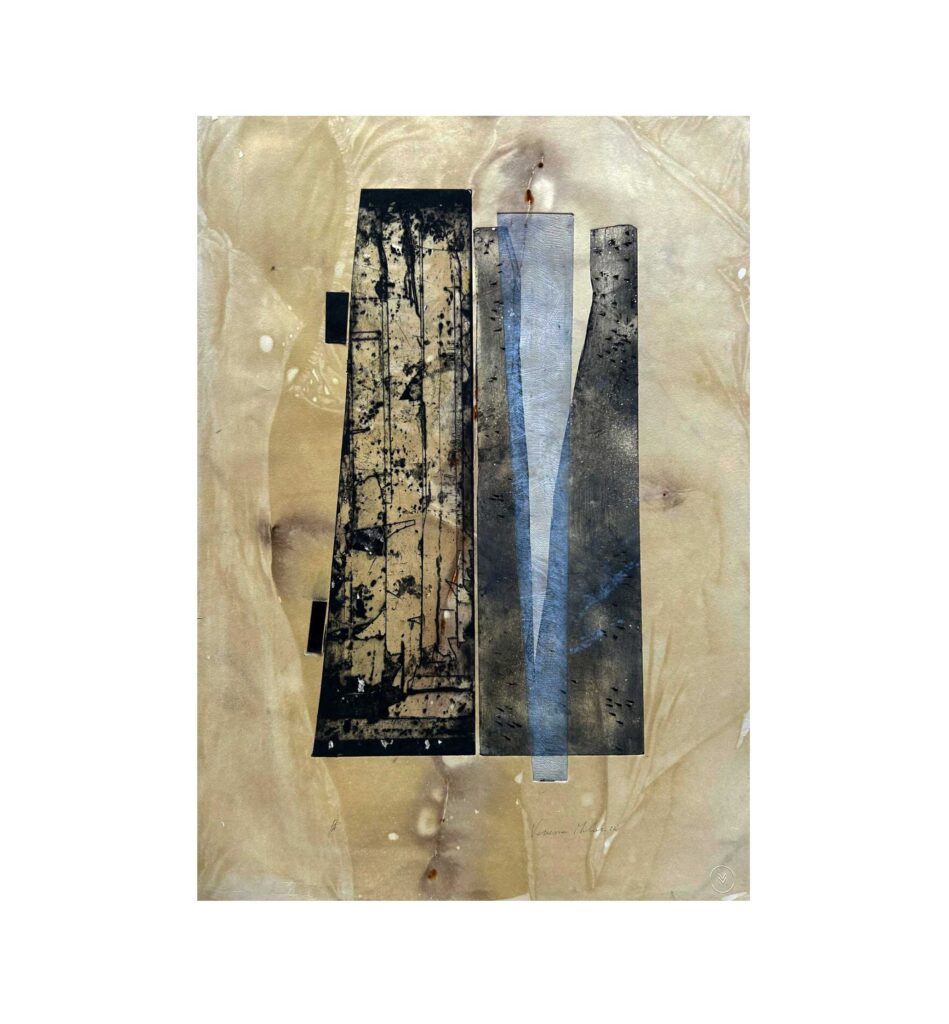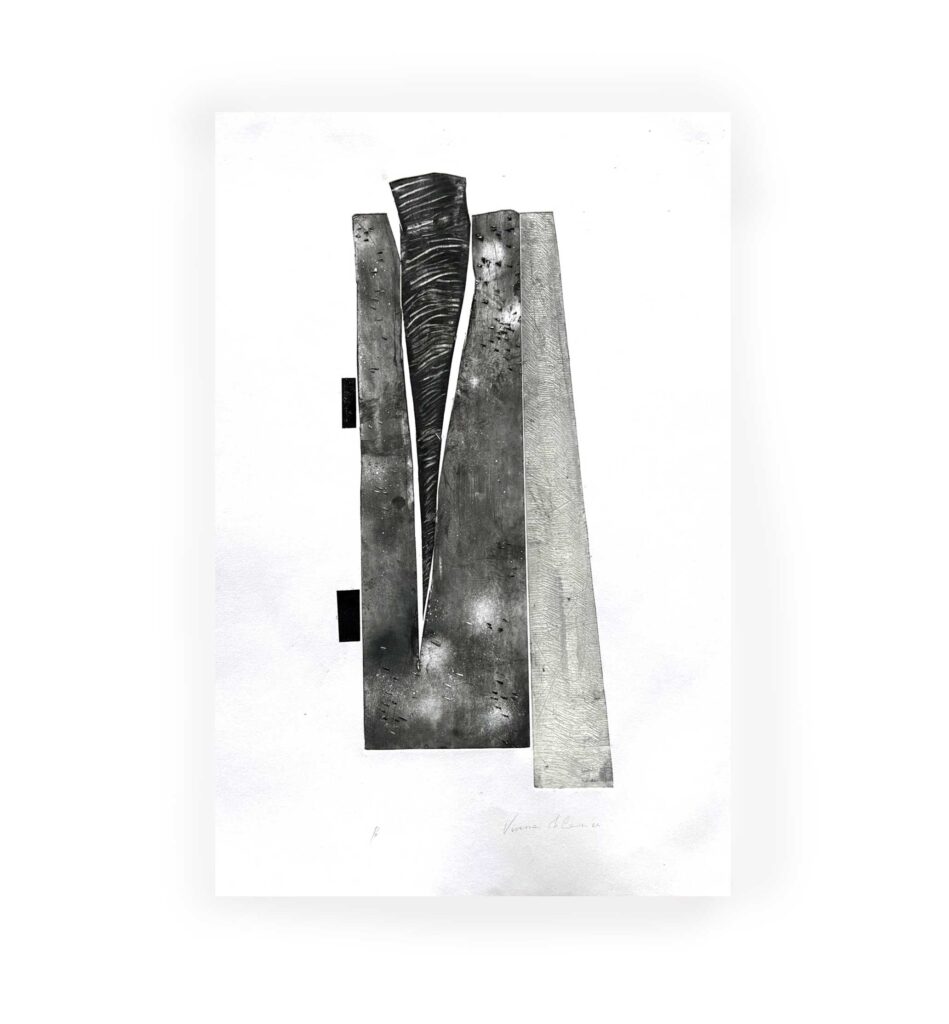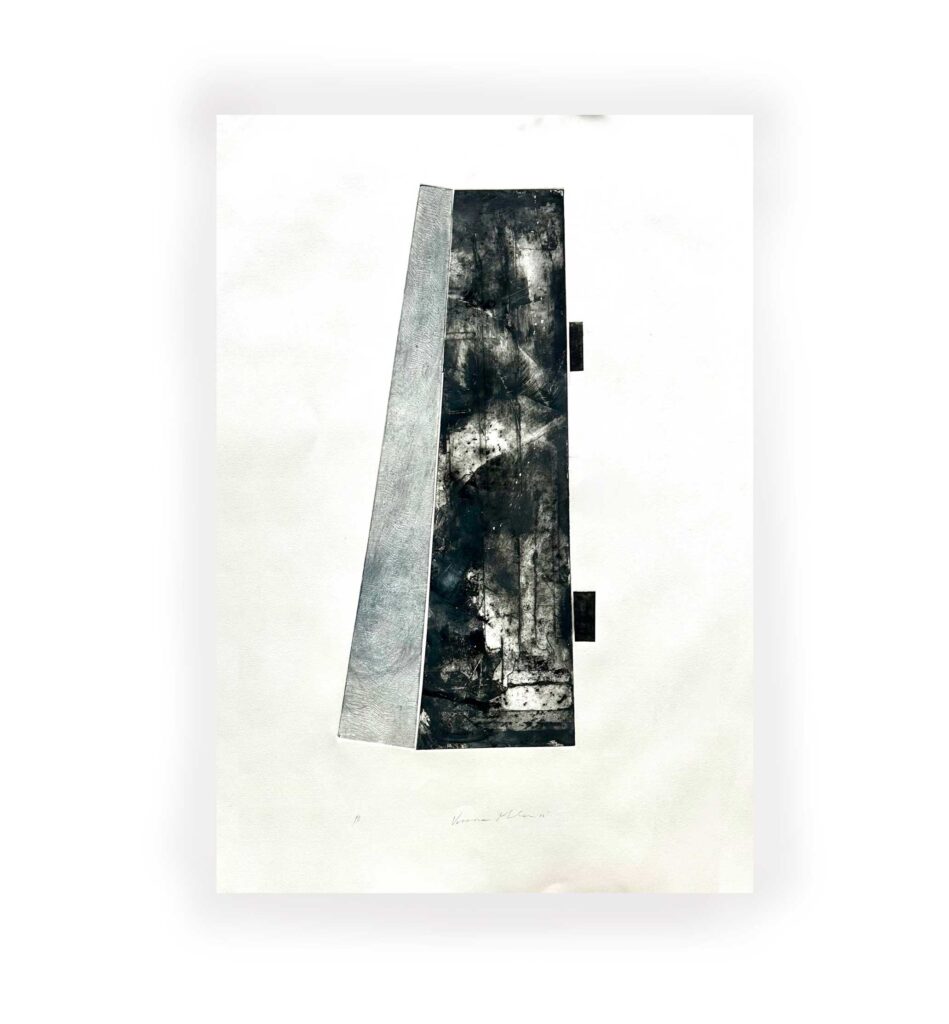No products in the cart.

Valter Černeka
Ospite In Laguna #1
28 giugno – 27 luglio 2024
Atelier Vanessa Milan, Venezia
The Stones of Venice
For this inaugural moment of OIL, we invited Valter Černeka (Pula, Croatia, 1987), whom we have known for a long time and with whom we have collaborated on several occasions, together or separately. Valter studied at the Academy of Fine Arts in Venice, where he graduated in 2013 in sculpture. During this course of studies he deepened the technique of engraving and met many friends, including Vanessa, whom he invited in 2012 and 2013 with Tiziano Ciao to participate in 7 Dana Stvaranja (7 days of creation) in Pazin. Vanessa and I met in 2013, the year in which I proposed that we curate an exhibition together dedicated to the graphic collection of the CAMeC Centro Arte Moderna e Contemporanea in La Spezia. The exhibition itinerary, inaugurated in June 2013 in the Project Room, proposed a selection of works chosen according to printing techniques and in each section thus obtained, were inserted works made by the members of the Lab43 group, to which Milan was linked at the time. In the lithographs section, two graphics by Valter were also exhibited, to whom in 2022, I dedicated together with Camilla Finzi an exhibition day: his engravings were set up in a private home, in an informal and welcoming atmosphere, while the comings and goings of the public alternated between a friendly visit and the professionalism of a gallery.

Valter’s interpretation of our invitation focused on sculpture. Having lived and studied in Venice for several years, he spontaneously formulated the thought underlying his presence in the lagoon. Starting from his birthplace and his artistic training, he identified Istrian stone as a common denominator between the history of the urbanization of Venice and that of the region where he lives. The Istrian stone with which Venice was built comes mainly from the quarries of Poreč and Pola, cities in Istria that are now part of Croatia, but it is also often used to build houses in this country. The abandonment of the countryside to go and live in the city has left destroyed and abandoned houses on Croatian territory, from which Valter takes elements that, through this appropriation and, sometimes through his intervention, become works in a series, which since 2013 he has called Erte/Piedritti. The series, still under development, has been enriched with two sculptures presented in the atelier’s showcase from 28 June to 27 July 2024. The “erte” – a Croatian dialect word, used, by an unforeseeable coincidence, also in the Venetian dialect – are structural architectural elements that function as thresholds, such as jambs, frames, steps, and are characterised by traces of use and time: grey patina, scratches, restoration interventions make them special and aesthetically attractive, while the vertical arrangement imposed by the artist transforms the space they occupy. Istrian stone is white in colour with streaks of other materials or fossils when extracted from the quarry and takes on the grey patina through exposure to atmospheric agents. In Černeka’s words: “the Piedritti possess their own energy, pure without being further altered by chisels. In some cases they undergo manual processing, taking on vitality and movement, a new light rejuvenates them, presenting the sculpture as an archaic poem that indicates what cannot be said otherwise” (1). Beyond the geographical borders, the geology of the Croatian territory overturns on Venetian architecture, Černeka’s personal history is intertwined with that of his country of origin and that of Venice, highlighting how there is no “solution of continuity between the Venetian shipyards and the Istrian quarries; and it was a fact dictated by pragmatism and practice […] The Istrian stone in Venice therefore represents a common heritage of the two shores; it is not the fruit of colonialism, but of an Adriatic of other times, when it was a road and certainly not a frontier” (2). His sculptures participate in the life of the Venetian stones, out there from the atelier, and share the same geological and historical memory. A short circuit that also recalls the famous book by John Ruskin, The Stones of Venice, written between 1851 and 1853, precisely while he was staying in Venice. A book that you come across on school desks, but that I had never read, and this was the perfect opportunity to fill the gap, while Valter had studied it for one of the courses he attended at the Academy. Precisely during a morning walk the day after the inauguration with Valter’s family and other friends, we at a certain point found ourselves in front of La Calcina, the hotel where Ruskin lived and worked during his stay in Venice. A seal for us of what we had achieved the day before in Vanessa’s Atelier. The stones studied, drawn, and recounted by Ruskin almost two hundred years ago are the stones with which Černeca’s sculptures dialogue and reinterpret and update the teaching and gaze of the English theoretician and watercolourist, who was well aware of their Istrian origin. Analysing the sculptures more closely, we notice that Valter intervened on the two stones, single blocks, with different degrees of abstraction and investigation into the relationship between base and sculpture. In one, he smoothed the lower part – only the four sides, while the part that cannot be seen and that rests on the ground remains original – to reveal the white of the stone, creating a sort of base, which lightens the original stone and becomes a pedestal. In the upper, grey part, a hole is visible, where perhaps the hinge of a door or a window or an iron bar was housed, undoubtedly a formal element on which the attention of the viewer is focused. You can also see some restorations in concrete, traces of workmanship, which tell us about a time gone by before this stone was recovered to be brought to Venice. The two colors of which it is composed, the original one, white, and the one given by time, gray, reinforce each other, representing two moments of the same story. Seeing an image of the sculpture in preparation, I instinctively compared it to the Seagram Building by Ludwig Mies van der Rohe, built in New York in 1958. The lower part of the imposing building in steel, bronze, glass and concrete, is left free, floating, empty, light in contrast with the rest of the building. An intuition of Mies, which makes this skyscraper unique and the work of the German architect brilliant. A simple structural element in stone thus became a modernist building soaring upwards thanks to the removal of material in the lower part of the sculpture.
A procedure that is repeated but reversed in the second sculpture: in the single block the Croatian sculptor carves out a sinuous abstract shape, a sort of ring, while the unworked base takes on the more traditional forms of a pedestal, although it is not technically one, since it is an integral part of the sculpture. As often happens with contemporary sculpture, these two also pay homage to the Romanian master Constantin Brâncuşi, who in the first half of the 20th century created abstract forms in sculpture, investigated the internal relationships between them and experimented with materials, leaving us solutions that are still inspiring.
Starting from Valter’s sculptural proposals, Vanessa created four different compositions with matrices that she recovered in the studio and on which she intervened strongly with a hammer and burnisher, after having cut them with a large metal cutter. The shapes thus obtained create new compositions of great visual power on the press. The print has been enriched in the chromatic range of white, which oxidizes and turns to grey/blue, alluding to the process to which the Istrian stone is subjected, which is originally white, and then covered with a grey patina, due to pollution, water and atmospheric agents. The compositions thus obtained in Vanessa’s four graphic works depart from her usual figurative repertoire, to enter a more decidedly abstract and monumental dimension. The approximately 100 x 70 cm sheets add volume and strength to the composition. A favorable coincidence also meant that Vanessa remembered that years ago Valter had given her a sheet of printing paper, already partly used, engraved, colored with an infusion based on green tea, which made it yellowish. She recovered it and impressed its shapes and colors, merging, like water and oil, present and past, memory-recollection and memory-action, and obtaining a muscular and mechanical abstraction that approaches in style and result the avant-gardes of the early twentieth century, especially the results of Russian Constructivism and Suprematism. The paper, 100% pressed cotton, wetting it before printing, takes on the consistency of canvas under the press, the drawing becomes three-dimensional and the color movement. During the inauguration we left on display some drawings, sketches from which Milan started and some elements that entered the composition: a few simple testimonies of the making that can only allude to the happy and intense creative moment in which the four engravings were made.
For both Vanessa and Valter, graphic production, using the various printing techniques, is an integral part of their artistic work. Both have made their training a profession: Vanessa first founded the DoppioFondo laboratory with Tiziano Ciao and since last year the Atelier Vanessa Milan; Valter with the Studio Mot, which carries out an investigation into engraving as an analogical tool to record the traces of everyday life, offers services for artistic education and the design and technical support for the preparation of exhibitions. Surely, friendship and mutual respect have created complicity and understanding, which is evident in the references between the works exhibited during this month. The depth of the works resulting from this first appointment is surprising and casts a pleasant expectation on future appointments.
2.Text sent by email by Valetr Černeka in April 2024
3. Nedo Fiorentin (ed.), La pietra d’Istria e Venezia. Atti del Seminario di studio, Venice, 3 October 2003, Regione del Veneto, Cierre Edizioni, Venice 2003, p. 20




Valter Černeka He obtained a master’s degree in sculpture at the Academy of Fine Arts in Venice in 2013. In addition to sculpture, he is involved in the field of graphics and art education.
In 2016 he founded MOT, a company that operates in the cultural-artistic sector in which the technical aspect (assembly of works and installations in museums and international art venues) and artistic production coexist and which acts as an incubator of ideas (realization of workshops and consultancy).
At the same time he continues to work with traditional graphic techniques, which he uses as a visual document, as an analogical tool that records the traces of human everyday life. While in sculpture he uses natural elements or materials considered waste, through the use of which he searches for a free form, passing through the critical observation of the relationship between man and landscape.
